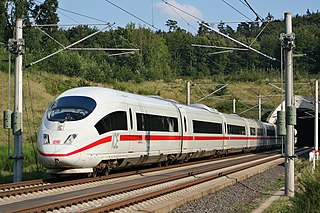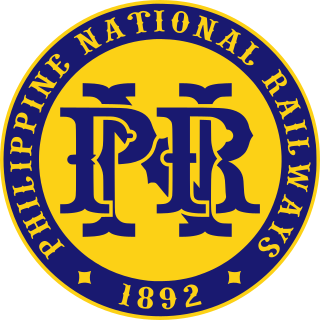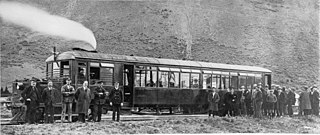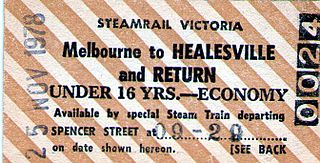
A diesel multiple unit or DMU is a multiple-unit train powered by on-board diesel engines. A DMU requires no separate locomotive, as the engines are incorporated into one or more of the carriages. Diesel-powered single-unit railcars are also generally classed as DMUs. Diesel-powered units may be further classified by their transmission type: diesel–mechanical DMMU, diesel–hydraulic DHMU, or diesel–electric DEMU.

A train is a series of connected vehicles that run along a railway track and transport people or freight. Trains are typically pulled or pushed by locomotives, though some are self-propelled, such as multiple units. Passengers and cargo are carried in railroad cars, also known as wagons. Trains are designed to a certain gauge, or distance between rails. Most trains operate on steel tracks with steel wheels, the low friction of which makes them more efficient than other forms of transport.

A multiple-unit train or simply multiple unit (MU) is a self-propelled train composed of one or more carriages joined, which when coupled to another multiple unit can be controlled by a single driver, with multiple-unit train control.

A railcar is a self-propelled railway vehicle designed to transport passengers. The term "railcar" is usually used in reference to a train consisting of a single coach, with a driver's cab at one or both ends. Some railway companies, such as the Great Western, termed such vehicles "railmotors".

A railroad car, railcar, railway wagon, railway carriage, railway truck, railwagon, railcarriage or railtruck, also called a train car, train wagon, train carriage or train truck, is a vehicle used for the carrying of cargo or passengers on a rail transport network. Such cars, when coupled together and hauled by one or more locomotives, form a train. Alternatively, some passenger cars are self-propelled in which case they may be either single railcars or make up multiple units.

The Philippine National Railways (PNR) is a state-owned railway company in the Philippines which operates one commuter rail service between Metro Manila and Laguna, and local services between Sipocot, Naga and Legazpi in the Bicol Region. It is an attached agency of the Department of Transportation.

A rail yard, railway yard, railroad yard (US) or simply yard, is a series of tracks in a rail network for storing, sorting, or loading and unloading rail vehicles and locomotives. Yards have many tracks in parallel for keeping rolling stock or unused locomotives stored off the main line, so that they do not obstruct the flow of traffic. Cars or wagons are moved around by specially designed yard switcher locomotives (US) or shunter locomotives (UK), a type of locomotive. Cars or wagons in a yard may be sorted by numerous categories, including railway company, loaded or unloaded, destination, car type, or whether they need repairs. Yards are normally built where there is a need to store rail vehicles while they are not being loaded or unloaded, or are waiting to be assembled into trains. Large yards may have a tower to control operations.

The Victorian Railways (VR), trading from 1974 as VicRail, was the state-owned operator of most rail transport in the Australian state of Victoria from 1859 to 1983. The first railways in Victoria were private companies, but when these companies failed or defaulted, the Victorian Railways was established to take over their operations. Most of the lines operated by the Victorian Railways were of 5 ft 3 in. However, the railways also operated up to five 2 ft 6 in narrow gauge lines between 1898 and 1962, and a 4 ft 8+1⁄2 instandard gauge line between Albury and Melbourne from 1961.

Rail freight transport is the use of railroads and trains to transport cargo as opposed to human passengers.

Dieselisation is the process of equipping vehicles with a diesel engine or diesel engines.

The NZR RM class Clayton steam rail motor was a unique railcar that was operated by New Zealand Railways (NZR) for New Zealand's national rail network and one of only two steam railcars to operate in New Zealand - the other being 1925's RM class Sentinel-Cammell.

The NZR RM class Wairarapa railcar was a class of railcars on New Zealand's national rail network. They entered service in 1936 and were classified RM like all other classes of railcars in New Zealand; they came to be known as the "Wairarapa" class as they were designed to operate over the famous Rimutaka Incline to the Wairarapa region on the Wairarapa Line. They also acquired the nickname of "tin hares" in New Zealand railfan jargon. The first two to be introduced re-used the numbers RM 4 and RM 5 that had previously been used by the withdrawn experimental Model T Ford railcars. The class consisted of six passenger railcars and one passenger-freight railcar. It is often described incorrectly as a class of six railcars.

The Healesville railway line, in Melbourne, Australia, was the non-electrified continuation of the suburban Lilydale line, extending into the Yarra Valley. The line closed in the 1980s, but a heritage railway group, the Yarra Valley Railway, is working to retain part of the line between Yarra Glen and Healesville.

The NZR RM class Sentinel-Cammell was a steam-powered railcar operated by the New Zealand Railways Department (NZR). It was the only one of its type to operate in New Zealand, and one of only two steam railcars trialled in the country; the other was the Clayton steam railcar.

A passenger train is a train used to transport people along a railroad line. These trains may consist of unpowered passenger railroad cars hauled by one or more locomotives, or may be self-propelled; self propelled passenger trains are known as multiple units or railcars. Passenger trains stop at stations or depots, where passengers may board and disembark. In most cases, passenger trains operate on a fixed schedule and have priority over freight trains.
This article lists some of the terminology used at present and in the past by railway employees, railway enthusiasts and railway historians in Australia. Many appear from time to time in specialist, rail-related publications. Significant regional variations exist, indicated by abbreviations of the state or railway.
The Quebec North Shore and Labrador Railway is a private Canadian regional railway that stretches 414 kilometres (257 mi) through the wilderness of northeastern Quebec and western Labrador. It connects Labrador City, Labrador, with the port of Sept-Îles, Quebec, on the north shore of the St. Lawrence River. QNS&L is owned by Iron Ore Company of Canada (IOC), and is a common carrier.

The PNR South Main Line is one of the two trunk lines that form the Philippine National Railways' network in the island of Luzon, Philippines. It was opened in stages between 1916 and 1938 by the Manila Railroad. Services peaked in the 1940s until the late 1960s, when the system started to decline. Since 1988, it was the only functioning inter-city rail after its counterpart to the north, the North Main Line, was closed. The intercity section of the line in Laguna, Quezon and the Bicol Region was then closed and reopened repeatedly between 2004 and 2014 due to a combination of declining ridership and was closed since then. Currently, only a little more than half of line is operational PNR Metro Commuter Line between Tutuban station and Laguna, Inter-Provincial Commuter from San Pedro to Lucena and the Bicol Commuter regional rail service between Sipocot, Naga Camarines Sur and Legazpi Albay.

The PNR North Main Line is one of the two trunk lines of the Philippine National Railways in the island of Luzon, the other being the PNR South Main Line. The line during its maximum extent led to various cities and municipalities in Central Luzon and the Ilocos Region.

The Manila Railroad Company (MRR) was a Filipino state-owned enterprise responsible for the management and operation of rail transport in the island of Luzon. It was originally established by an Englishman named Edmund Sykes as the private Manila Railway Co., Ltd. on June 1, 1887. British engineer Horace L. Higgins was then assigned at the helm in Manila as its first general manager. On July 7, 1906, a separate private entity named the Manila Railroad Company of New Jersey was established. The two companies continued to own the Luzon railroad network until February 4, 1916 when the Insular Government acquired both companies and absorbed them into the new Manila Railroad.


























